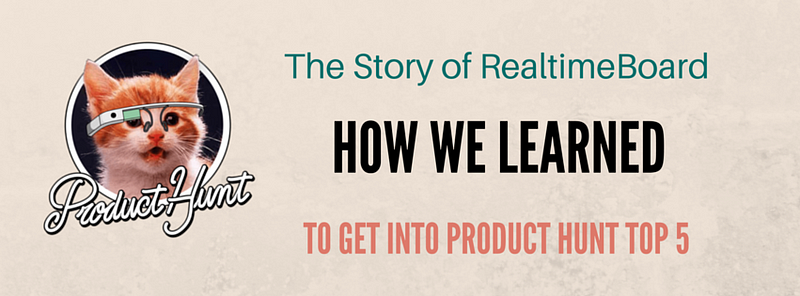Age of Product’s of Food for Thought of December 27th, 2015 covers: Best practices on how to get to #5 on Product Hunt, Steli Efti on when and how to pivot, Dave McClure on the power of niches to grow a business from, Ken Norton on product management and aiming for 10x, not 10%, how to build product roadmaps, the cost of frustration and Roman Pichler on how to pick the right KPI for product performance.
(via RealtimeBoard): How We Learned to Get Into Product Hunt Top 5. The Story of RealtimeBoard

But our story is special. While many companies describe their Product Hunt experience as success OR failure (or describe nothing), we managed to achieve both fail and success — with a unique chance to learn lessons from both sides of the scale. So if you’re looking to get featured on Product Hunt, read our story and learn from our mistakes to improve your performance and benefit your startup.
and : 058: How and When to Pivot
There seems to be a lot of confusion on what a business pivot really is. Today we are going to clear up what the term means, what really constitutes a pivot, and give some advice on how to approach a pivot in your business.
(via Medium): Niche to Win, Baby.
Don’t Go Big or Go Home. Go Small at first, then Iterate, Dominate, & WIN.
In fact most startups can be incredibly mediocre & still be very successful.(sounds so inspirational, right? i know, but stick with me for a minute…) But that’s exactly the point: If it’s crappy but still works and/or is useful, that’s a great sign… that means there could be a lot more potential ahead.
(via Google Ventures): 10x Not 10%
For more than a century, the Eastman Kodak Company dominated the photography market. From Hollywood, to the Apollo project, to family reunions, Kodak was there, recording our lives. Known for innovation, Kodak has been called “the Google of its day.”
(via Medium): The Cost of Frustration
Poor design creates friction. Friction can manifest itself as a shopper abandoning a sale. Alternatively, employees may spend more time than necessary obtaining a critical piece of information. The less the design jives with what the user is trying to accomplish, the more friction increases. Whenever friction occurs, someone becomes frustrated. The user may feel the frustration because they can’t complete their task. Employers may become frustrated because their charges are taking too long for critical functions. A poor design results in high friction. High friction results in high frustration.
(via ProductPlan): 4 Steps to a Prioritized Product Roadmap
Whether you’re using a scoring model or some other kind of model to evaluate and prioritize opportunities, the technique you’re using is ultimately less important than the conversation that you’re having with your stakeholders.
: How to Run Your Company Based on Metrics: What, Why, How, Who, and When
I review a lot of board decks with a beautifully hand-crafted page with metrics for the company. That makes me nervous. I prefer to see a screenshot of an internal dashboard, not something created for the board, and I prefer to see that same dashboard in the same format at every meeting.
(via TechCrunch): How To Plan For Your Startup’s Gruesome Demise
Well-conditioned entrepreneurs pay lip service to downside risks and say the right things following a financing. They’ll say, “Funding isn’t a milestone to celebrate,” and “We enjoy tonight, but back to business as usual tomorrow,” but very few founders have thought about the risks in a constructive, actionable way.
: 10 Tips on How to Choose the Right Product Key Performance Indicators (KPIs)
Product key performance indicators (KPIs) are metrics that measure your product’s performance. They help you understand if the product is meetings its business goals and if the product strategy is working. Without KPIs, you end up guessing how your product is performing. But choosing the right indicators is not always straightforward.
: Software has diseconomies of scale – not economies of scale
Software development does not have economies of scale. In all sorts of ways software development has diseconomies of scale. If software was sold by the pint then a four pint carton of software would not just cost four times the price of a one pint carton it would cost far far more.

